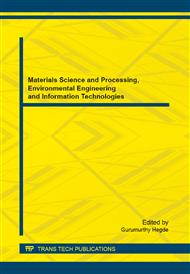[1]
A. Shamir, How to share a secret, Communications of the ACM, 22 (1979) 612-613.
DOI: 10.1145/359168.359176
Google Scholar
[2]
G. R. Blakley, Safeguarding cryptographic keys, Proceedings of AFIPS National Computer Conference, New York, 1979, pp.313-317.
Google Scholar
[3]
M. Ito, A. Saito, T. Nishizeki, Secret sharing schemes realizing general access structure, Proceedings of IEEE Global Telecommunication Conference, New Jersey, 1987, pp.99-102.
Google Scholar
[4]
P. Morillo, C. Padro, G. Saez, J. L. Villar, Weighted threshold secret sharing schemes, Information Processing Letters, 70 (1999) 211-216.
DOI: 10.1016/s0020-0190(99)00070-8
Google Scholar
[5]
H. M. Sun, B. L. Chen, Weighted decomposition construction for perfect secret sharing schemes, Computers and Mathematics with Applications, 43 (2002) 877-887.
DOI: 10.1016/s0898-1221(01)00328-5
Google Scholar
[6]
P. Feldman, A practical scheme for non-interactive verifiable secret sharing, Proceedings of the 19th Annual ACM Symposium on Theory of Computing, New York, 1987, pp.427-437.
DOI: 10.1109/sfcs.1987.4
Google Scholar
[7]
T. P. Pedersen, Non-interactive and information-theoretic secure verifiable secret sharing, CRYPTO'91, LNCS 576, Springer-Verlag, Berlin, 1992, pp.11-15.
DOI: 10.1007/3-540-46766-1_9
Google Scholar
[8]
A. Herzberg, S. Jarecki, H. Krawczyk, M. Yung, Proactive secret sharing or how to cope with perpetual leakage, CRYPTO'95, Berlin, 1995, pp.339-352.
DOI: 10.1007/3-540-44750-4_27
Google Scholar
[9]
Y. Desmedt, S. Jajodia, Redistributing secret shares to new access structures and its applications, Technical Report ISSE TR-97-01, George Mason University, (1997).
Google Scholar
[10]
E. D. Karnin, J. W. Greene, M. E. Hellman, On secret sharing systems, IEEE Transactions on Information Theory, 29 (1983) 35-41.
DOI: 10.1109/tit.1983.1056621
Google Scholar
[11]
T. P. Pedersen, A threshold cryptosystem without a trusted party, Eurocrypt'91, LNCS 547, Springer-Verlag, Berlin, 1991, pp.522-526.
DOI: 10.1007/3-540-46416-6_47
Google Scholar
[12]
T. Tassa, Hierarchical threshold secret sharing, Journal of Cryptology, 20 (2007) 237-264.
DOI: 10.1007/s00145-006-0334-8
Google Scholar
[13]
A. Parakh, S. Kak, Space efficient secret sharing for implicit data security, Information Sciences, 181 (2011) 335-341.
DOI: 10.1016/j.ins.2010.09.013
Google Scholar
[14]
K. Kurosawa, General error decodable secret sharing scheme and its application, IEEE Transactions on Information Theory, 57 (2011) 6304-6309.
DOI: 10.1109/tit.2011.2161927
Google Scholar
[15]
M. Nojoumian, D. R. Stinson, M. Grainger, Unconditionally secure social secret sharing scheme, IET Information Security, 4 (2010) 202-211.
DOI: 10.1049/iet-ifs.2009.0098
Google Scholar


